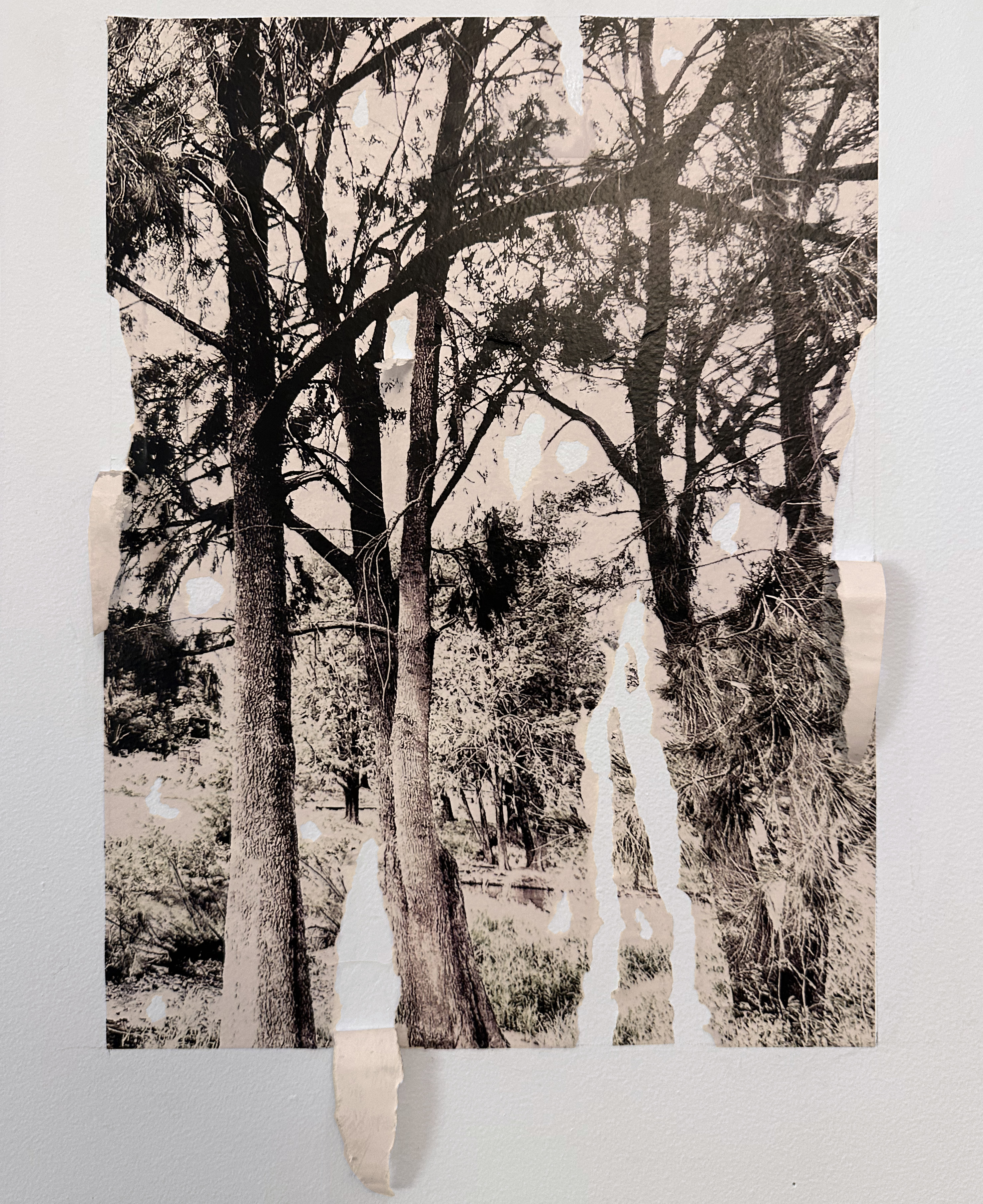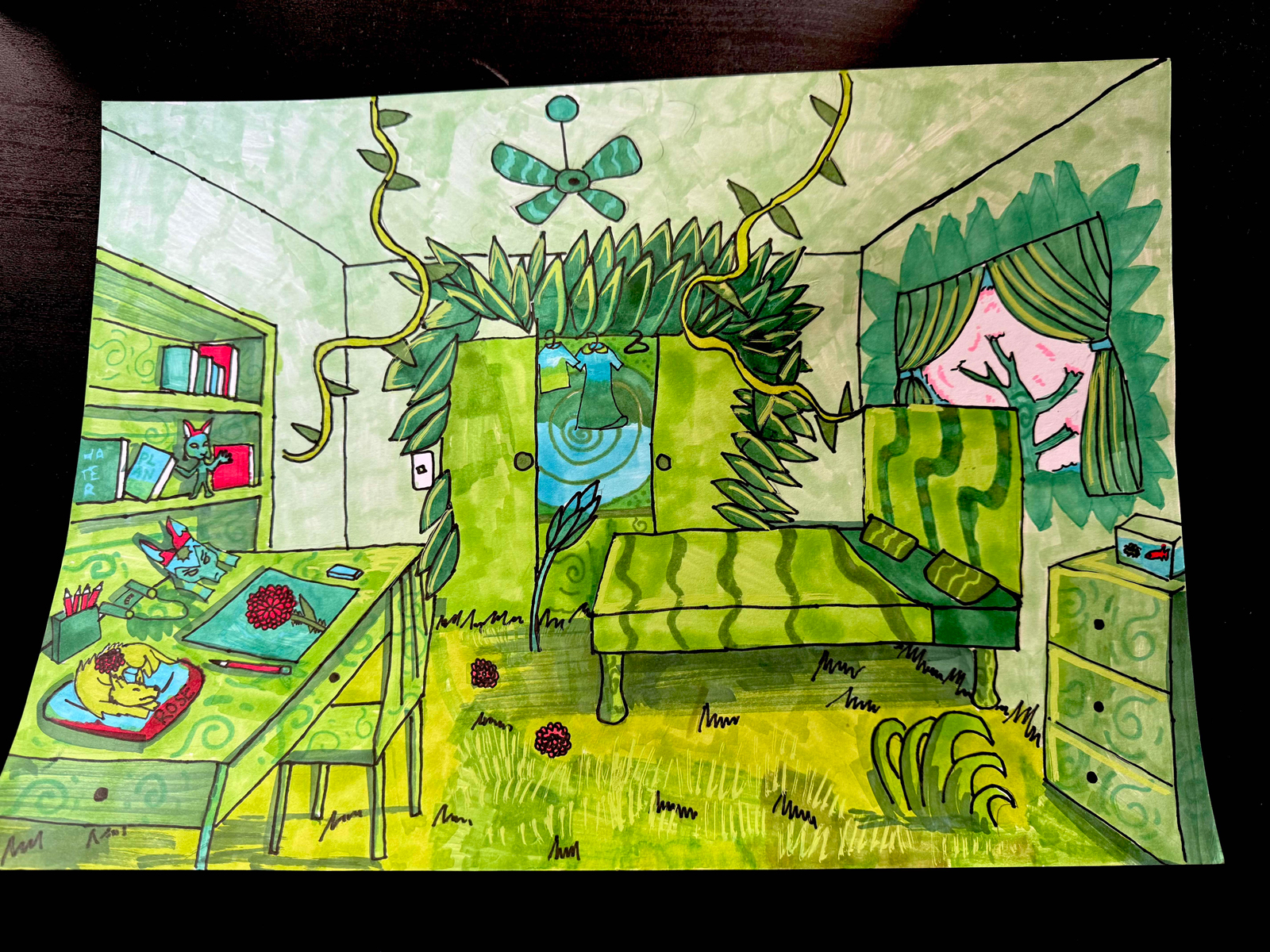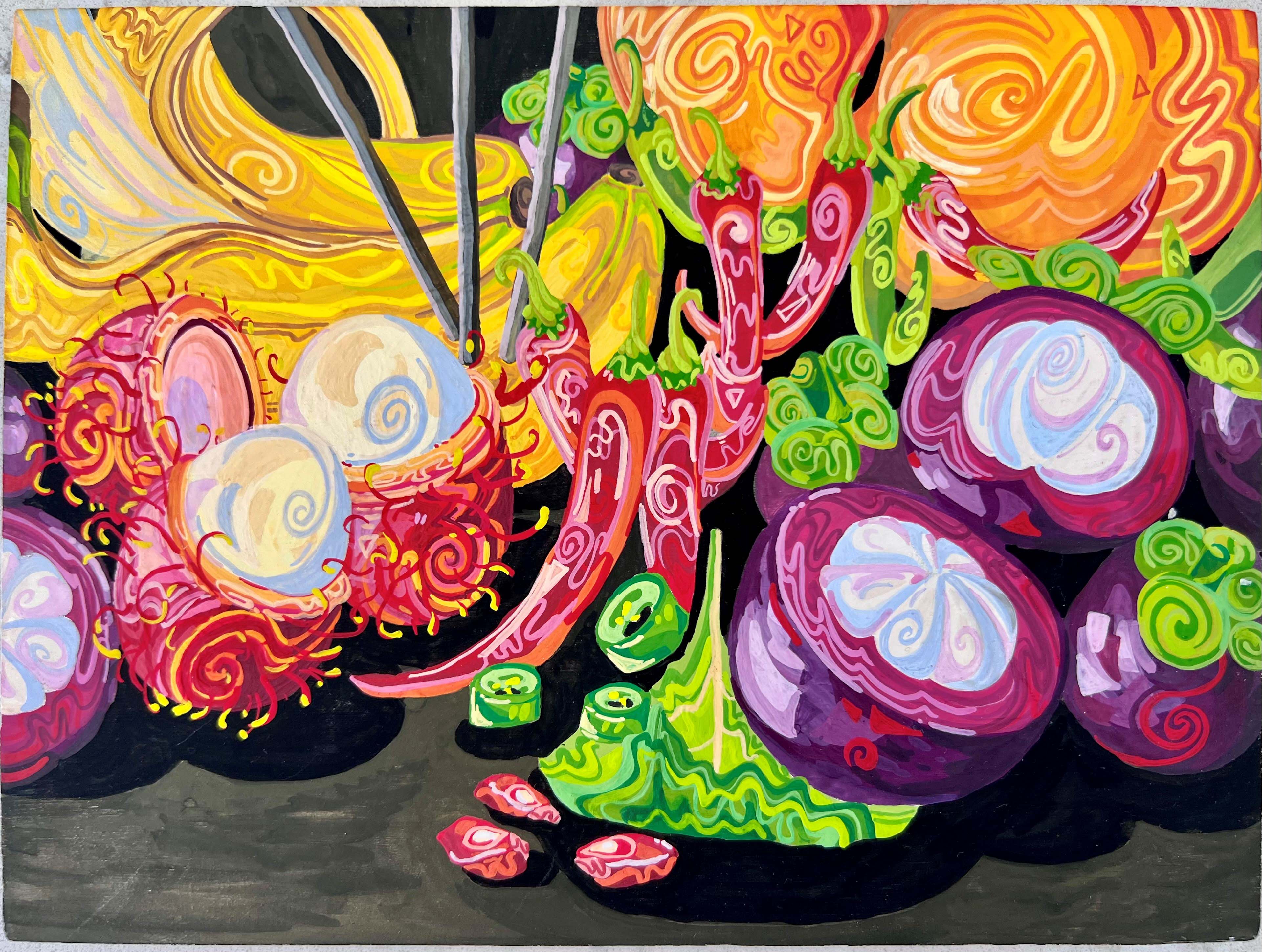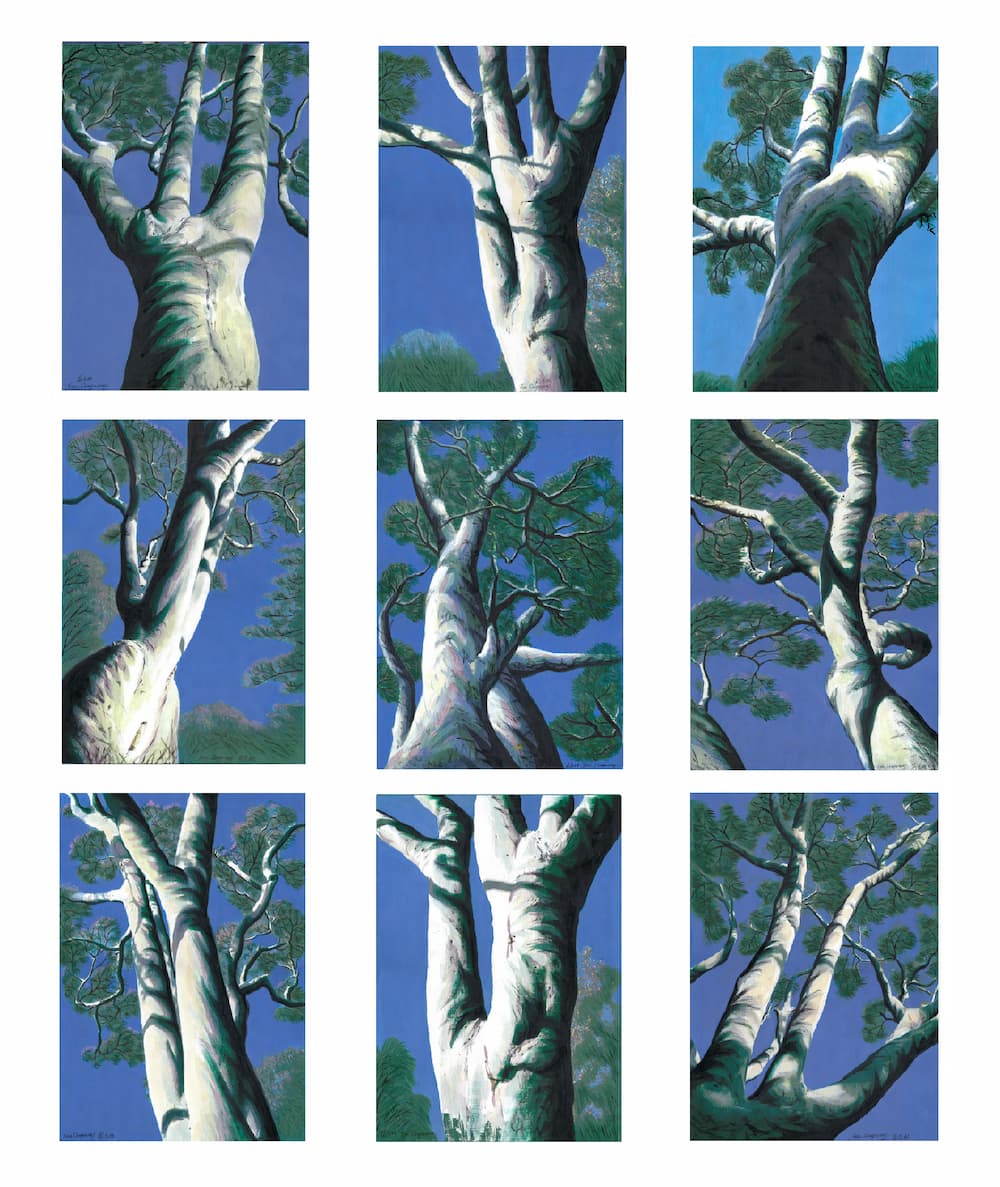Prize Winners
Congratulations to the winning artists and designers selected by this year's judges Creative Director of Sydney Design week Keinton Butler and contemporary artist Ramesh Mario Nithiyendran. They were announced at the exhibition opening in July and presented with their prize.

The ArtHitects, Gary Carsley & Renjie Teoh, Wambuul (Proclamation Park Bathurst)
Winner, Art Category
72 torn, overlapping individual 80 gsm A4 prints on recycled copier paper, starch-based water-soluble glue, pencil drawn grid, 200x150cm
This work marks the site where in 1815 Governor Macquarie disposed the Wiradyuri of their country. The mutilated image reveals that coloniality originates and continues as rentier capitalism, reliant on effacing intimate relationships to the land. Supplanting models of custodianship with ownership enables unsustainable environmental degradation.
Using modest, renewable materials and a simple alpha-numerical grid to patiently apply sheets of wet, fragile paper directly to the wall highlights the values of tenderness and the importance of the manual as strategies of resistance to the exploitation of people(s) and the natural world. We conceptualise our work as a poultice.
Prize: $20,000
Judges' comments
The judges found Wambuul (Proclamation Park Bathurst) Wambuul (Proclamation Park Bathurst) by The Arthitects – Gary Carsley & Renjie Teoh, to be a standout work, notable for its materiality, performativity and engagement with the layered histories of the Australian landscape.
It thoughtfully addresses urgent and pertinent themes of environmental custodianship and colonial extractivism. The materiality of the work, coupled with its evocative and deliberate tearing, introduces a performative element that prompts viewers to consider their relationship with the Australian landscape and the perhaps arbitrary value placed on artworks by our cultural institutions.
This reconsideration is further encouraged by the inclusion of the image of a gilded frame which imparts a camp sensibility to the work. The judges also valued the cross-disciplinary collaboration between the architect and the artist.

Joanne Odisho, Lume
Winner, Design Category
bio composite - comprised of paper pulp and wood shavings, unryu rice paper, 60x40x40cm
Inspired by 19th-century paper dome observatories, this piece echoes past design and reimagines materiality.
The piece is crafted from a biodegradable composite comprised of shredded paper, wood shavings and natural additives.
The concept aligns with Carl Elefante’s idea that “the greenest building is the one that’s already built.” In a world teeming with overlooked resources, it’s our duty as designers to harness the abundance of materials destined for waste in our pursuit of sustainable and thoughtful design.
This product advocates for a world where past and present harmonise, and where products are not just functional but responsible and environmentally considerate.
Prize: $20,000
Judges' comments
Joanne Odisho’s Lume impressed the judges with its considered use of a biodegradable composite made from paper pulp, wood shavings, and rice paper, materials that added depth and texture while revealing the history embedded within them.
The refined form, paired with its hand-built quality and unconventional scale, positions it both as a sculptural object and lamp. Lume casts a beautiful, ambient light and would sit comfortably in a range of interior settings.
Through both materiality and concept, Odisho has created a piece that speaks to sustainability and resourcefulness, offering potential for commercialisation and scalability. The piece illustrates how designers are reworking existing biodegradable materials rather than contributing to the production of waste, a message aligned with the theme of the Prize.

Anahid Mezoghlian, The Busy Penguin
Joint Winner, Young Artist & Designer 7 - 12 years
canvas and paint, 26x20cm
I wanted to do a Little Penguin because they are endangered and live at Manly. I really like penguins. In my picture it is waddling to its mum and dad.
Prize: $500
Judges' comments
Anahid Mezoghlian’s The Busy Penguin impressed the judges with its strong graphic qualities and expressive character. The work responds directly to the local environment and captures a delightful, animated quality that brings the subject to life.

Angie Xu, Nature's room
Joint Winner, Young Artist & Designer 7 - 12 years
marker, 30x42cm
This is my imaginary room where nature has come alive. The furniture, walls, desks, bed, curtains and even the ceiling fan are covered in leafy green plants and flowers. It represents my deep connection with the environment.
Playful animal patterns and the tone of dark and light greens remind us of the importance of nature. and how we can care for nature and keep it close to us.
Prize: $500
Judges' comments
Angie Xu’s Nature’s Room is an imaginative work imbued with surrealist charm. Her use of colour reveals both maturity and restraint, contributing to a well-executed composition.
The artwork conveys a strong personal connection to the environment, demonstrating a sense of intimacy and depth in her response to the theme.

Meera Nirmalendran, Nature's Bounty
Winner, Young Artist & Designer 13 - 18 years
gouache paints, 15x20cm
In Nature’s Bounty, I present a still life that captures the vibrant abundance of tropical fruits not merely as objects of visual pleasure, but as symbols of ancestral knowledge and ecological interdependence.
Rendered with close attention to texture, colour and ripeness, the harvested fruits are positioned in varying states of fullness and impermanence to underscore both the richness and fragility of our relationship with the natural world. Ultimately in Nature’s Bounty I question the audience: in our pursuit of global abundance, what fruits of the earth, and what wisdom, are we willing to lose?
Prize: $2,000
Judges' comments
Meera Nirmalendran’s Nature’s Bounty demonstrated confidence through its refined scale and compelling composition. The intricate details invite closer viewing, while the thoughtful selection of fruits and vegetables, including chillis, mangosteens and rambutans, reflects a deep connection to ecology, culture, and the symbolic role of food in bringing people together across cultures and borders.
It is a sophisticated and layered response to the theme, exploring the pursuit of abundance and our relationship with the Earth.

Banjo Evans, Discarded World, Fading Creatures. 01
Highly Commended, Young Artist & Designer 13 - 18 years
acrylic paint and poscas on recycled corflute and cardboard, 200x120cm
My artwork has within it, dissonance to confront the devastating impact of human industrialisation from an animal’s perspective, and the theoretical future in which nature re-claims what was originally its own. Using neo- expressionism to define the animals abstract fear and primal defiance of humanity, I express how wildlife has come to perceive humans as a hostile force. Each surface created from recycled materials, emphasises the impact that human consumerism has on the environment.
Judges' comments
The judges found Banjo Evans’ Discarded World, Fading Creatures 01 to be joyous and spirited, clearly driven by a compelling urge to create. It was full of surprise, inviting viewers to look closely and to continue discovering the work’s references to the impacts of industry and the built environment. The subject matter - where wildlife perceives humans as a negative force - offers an important and timely commentary.
People's Choice Winners
Over the last few weeks, you had the chance to vote for your favourite works from our Environmental Art & Design Prize exhibition.
We can now reveal the 3 winners selected from the 191 finalist works by artists and designers across Australia. They were exhibited across 3 venues on the Northern Beaches and are on display until Sunday 14 September.

Fan Dongwang, Nine Gum Trees
People's Choice Winner, Art Category
acrylic and water colour on canvas paper, 190x146cm
This work explores the notion of painting Australian landscape using the techniques of Chinese painting, carving and calligraphy.
Humble, resilient and iconic, the Australian gum tree has been drowned under roiling floods, consumed in flames, fallen to the buzz of the miller’s saw and slowly choked with thirst. Yet each year it endures. The trees spread back across the land, from scorching deserts to desolate mountains. They become living things akin to human beings: their solemn trunks dance in the wind, their magnificent bodies transforming into awe inspiring human torsos. In the twilight they soar towards the sky in ecstatic salutation.
Prize: $1,000
About the artist
Born in Shanghai, China, Fan studied traditional Chinese art at Shanghai School of Arts and Crafts in 70’s and later became an art teacher there. As an established Shanghai artist, exhibited regularly since 1982. Awarded 1986 the Prize for Excellent Work for Shanghai International Culture Exchange. 1990 migrated to Australia as an artist of ‘Distinguished Talent’; Studied Master of Arts at COFA, UNSW in 1995 and completed Doctor of Creative Art at Wollongong University in 1999. Exhibited in NGA and numerous university and regional art galleries throughout Australia. Winners of Mosman, Fisher’s Ghost, Liverpool, Willoughby and Burwood Art Prize.
Lives in Ashfield, NSW

Susie Roberts, Star
People's Choice Winner, Design Category
porcelain, wood, paint, 12v led g4 bi-pin globe and holder, recycled plastic, transformer 8x34x34cm
This work blends the beguiling transparency of porcelain with slip cast delicacy to create warmth and light. As a ceramic artist connected to the Northern Beaches culture, the artist uses the dual strength and fragility of porcelain to highlight the precious nature of the ocean and its curious creatures. Working at the intersection of art and science the artist considers the beauty of the sea and its critical role as the largest carbon sink on the planet.
‘Star’ is inspired by the humble sea mollusc, the Star Limpet. Born into porcelain, the star gives guidance, energy and hope for the protection of the astounding ecosystem that is the world ocean. Whilst the work has its genesis in the sea, its reflection also lifts us into the night sky and the realms beyond.
Prize: $1,000
About the designer
Susie Roberts grew up barefoot in the bush around Mudgee, NSW, Australia. Her love of science, art and physical yakka led to a career in winemaking after a degree in Agricultural Science with first class honours from Sydney University and a Bachelor of Oenology from Charles Sturt University.
She made bold red wines for Huntington Estate whilst managing the Huntington Music Festival. This passion for music guided Roberts to the Sydney Philharmonia Choirs where she sang as a soprano in the Symphony Chorus.
Back to earth, Susie is excited to find her hands in clay. She completed a Diploma of Ceramics at Northern Beaches TAFE in 2022 and was a finalist in the 2022 Crackpot Cup Competition. In 2023 she was invited to partake in the Golden Light group exhibition at Crackpot Gallery. Susie has just completed her Advanced Diploma of Visual Arts (Ceramics) with a group exhibition, Beneath the Surface at Barometer Gallery, Paddington (Nov 2024) and is working toward The Coal Loader (2025). Her Sea Cups are available from the Object Shop at the Australian Design Centre.
Lives in Mosman NSW, studied at Northern Beaches TAFE – Ceramics.

Louie (Lucinda) Ornelas, Squawks the Grubinator
People's Choice Winner, Young Artists & Designers Category
acrylic paints on paper, 42x30cm
Louie LOVES baby animals so she drew a baby magpie instead of an adult. Louie and her family have a special magpie that comes into their yard and eats the grubs in the grass. Louie likes how intelligent magpies are.
Magpies host funerals for each other and have one soul mate for life.
Prize: $1,000
About the artist
Louie Ornelas is an eight-year-old student in year 3 at Mimosa Public School. Louie attends art classes on Saturdays and she loves painting, sewing, netball and drawing Bubba her pet bulldog.
Lives in Davidson, NSW.
